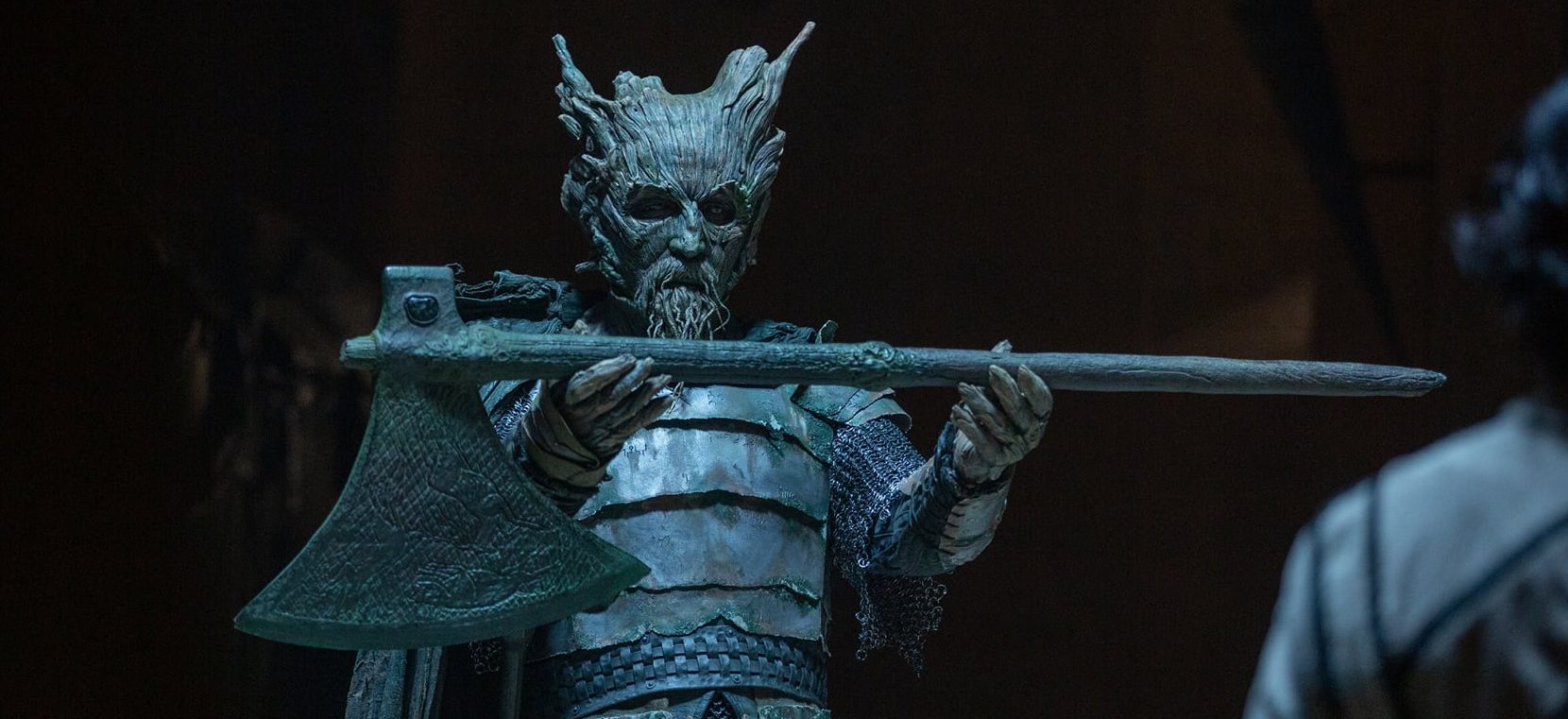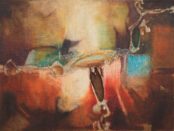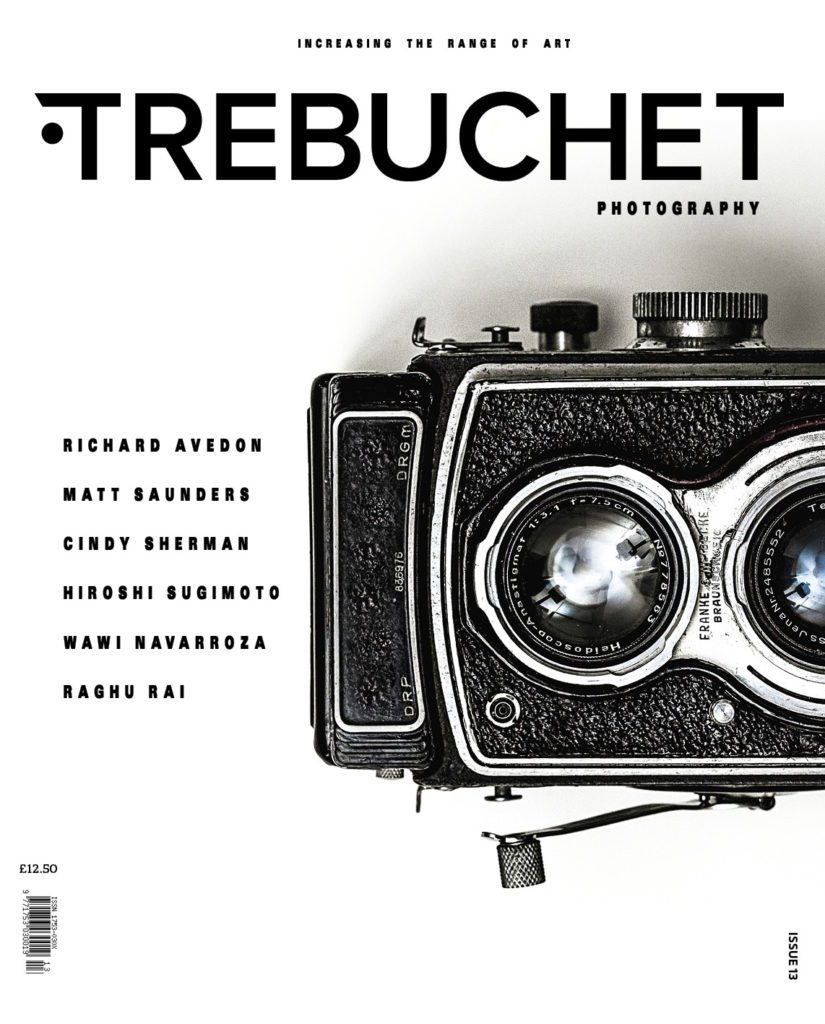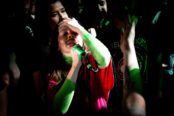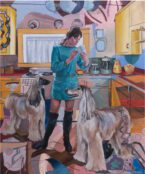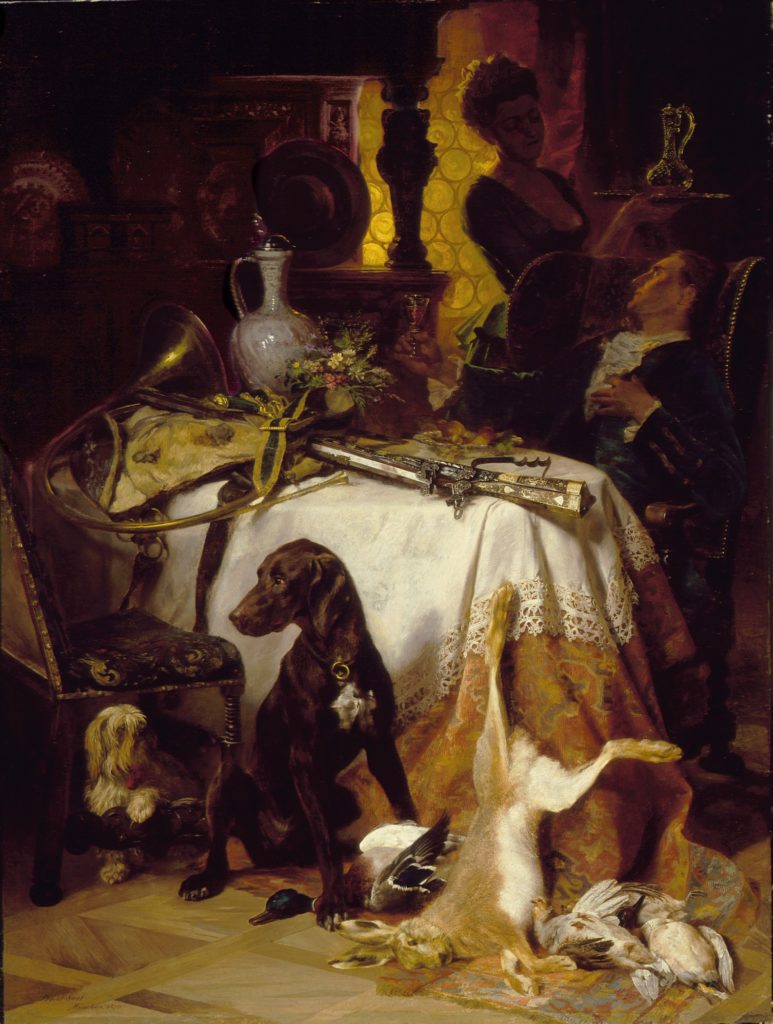The late medieval poem Sir Gawain and Green Knight (c. 1370) by the anonymous ‘Pearl’ or ‘Gawain’ poet is a foundational and complex text that has been translated and adapted in writing many times, becoming a staple of medieval studies and English literature. The original manuscript held at the British Library presents an ambiguous narrative open to diverse interpretation and follows the Knight Gawain as he travels to honour a challenge from the eponymous and monstrous Green Knight.
Having survived a beheading at Gawain’s hands the, green skinned and green adorned, ‘half giant’ explains that the return blow will be issued at the Green Chapel, an indeterminate and remote wilderness location that Gawain must locate and where he must present his head to the axe. The journey is physically and psychologically challenging, including what can be anachronistically called cinematic references to landscapes, hunting, and ambiguous trysts with ‘the lady’. While lending itself to cinematic framing the attempts to adapt the poem into a film have been uneven with the most recent, Lowery’s The Green Knight (2021), providing a thoughtful, but by no means definitive, interpretation.
1973/1984/1991
Filmed adaptations of the poem begin with Gawain and the Green Knight (1973) and the remake, Sword of the Valliant (1984), both efforts of Stephen Weeks. The 1973 version features Nigel Green in his final theatrical film as the Green Knight and Murray Head as Gawain, while the 1984 iteration sees Sean Connery as the Green Knight and Miles O’Keeffe in the Gawain role. The visual textures of Week’s films are flawed, described by critic Mark Kermode as ‘cod antics’ (2021). They move between re-enactment style set-piece combat to badly dated sword and sorcery, which is not helped by complex narrative digressions from the original text (involving riddles and a magic ring). In moving away from the poem and trying to emulate blockbuster movies (Weeks had hoped to secure Mark Hamill to play Gawain) both attempts failed to make an asset of clearly too-small budgets. There is no artful visual stylisation in the cinematography or costumes for example, or strong direction (emphasising landscape?) to help the films establish a believable language.
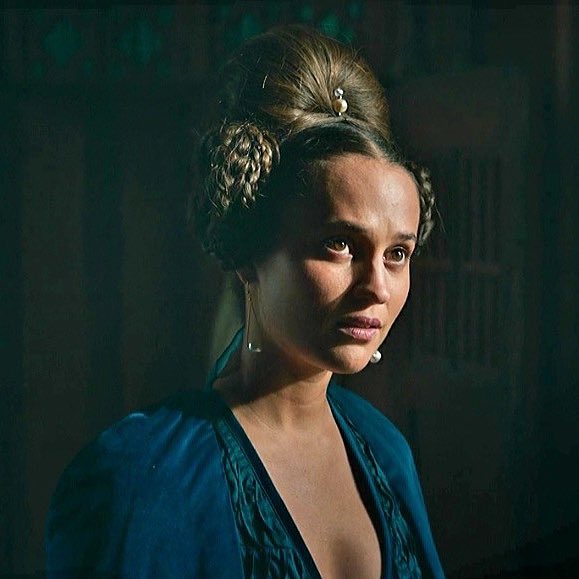
Additionally, J.M. Phillips’s, Gawain and the Green Knight (1991) adapted by David Rudkin (responsible for folk-horror classic Penda’s Fen, 1974) was a T.V play made by Thames Television. This humble production broadcast on Christmas eve surpassed both previous (1973, 1984) film adaptations by virtue of its loyalty to the text, the imposing figure of Malcolm Storry as the Green Knight and snippets of Welsh dialogue that hint at multiple antecedents to the story. It also includes reference to the exchange of winnings game that Gawain plays with Lord Bertilak, a key element lacking in the previous adaptations.
2021: The Green Knight
Mercifully David Lowery’s 2021 film adaptation, The Green Knight includes both an artful and considered visual style (accompanied by Daniel Hart’s strong score and accomplished cinematography by Andrew Droz Palermo) with a good budget and a better overall intension from Lowery: greater directional focus and clear thematic, evidenced through his choices of what to include, what to emphasise and what to leave out. His film sees Ralph Ineson as the Green Knight and Dev Patel as Gawain. Describing Lowery’s Gawain as ‘introspective and oddly passive’, Aronstein and Drummond (2021) emphasise the way the audience are asked to question Gawain and his reality throughout the film.
He moves through a dreamlike landscape, seeking meaning in a world that offers stark beauty but little in the way of answers. Lowery’s film does not explain its phenomena or justify its narrative beats. We, like Gawain, merely observe, grappling with uncertainty as his destiny plays out before us (Aronstein and Drummond, 2021:90).
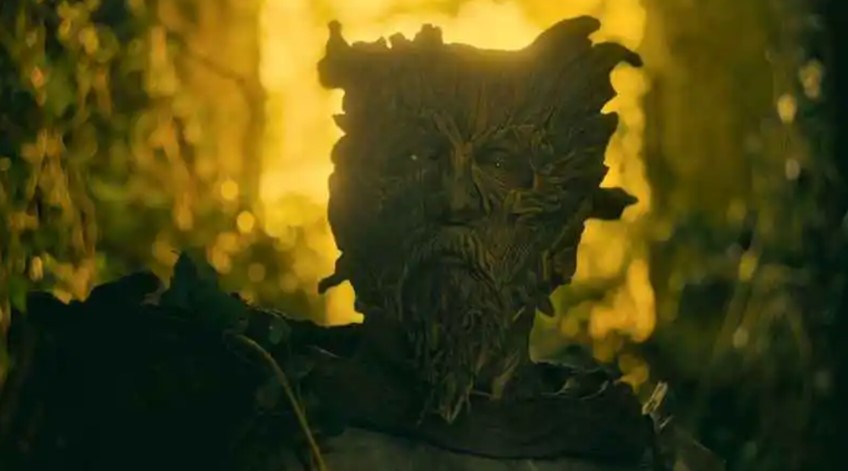
The visual texture of Lowery’s film benefits from an evolved screen language for the fantasy genre (which did not exist for example when Weeks made his films). This has seen The Lord of the Rings (2001-2003) (a direct reference for Lowery, see Welsh, 2021) and Game of Thrones (2011-2019) (Lowery’s makeup effect artist for the film Barrie Gower worked on GOT for six years) pioneer more serious, immersive and believable worlds.
I asked David Lowery about his choices related to the Green Knight’s appearance, he explained his emphasis for the presentation in the film highlighting ‘readable-into-ness’ stating that ambiguity is also key in the original text and he didn’t want to lose that. Lowery also talked about the importance of female power (in the poem Morgan le Fay, Arthur’s sister and Lady Bertilak have key roles in testing Gawain). ‘At one point I even considered changing his countenance [the Green Knight’s] to more directly suggest the female authority represented by Morgan Le Fey. I wound up skewing closer to the description in the poem but hopefully his thematic role still comes through loud and clear’ (Lowery, in correspondence with the author 2021).
That thematic role does come through, and the tension between the indecisive young man and the potent women he encounters is perhaps the most abiding aspect of Lowery’s adaptation, building on the original text’s feminist interpretations. The women in the film, while not the focus, are active, articulate, and morally resolute. This includes Sarita Choudhury as Mother (the Morgan le Fay role, in this case Lowery has imagined the sorceress as Gawain’s mother rather than his aunt as it is in the poem). ‘Mother’ is responsible for summoning the Green Knight in an act of blood magic and we are left feeling this is a prompt for her son to live up to (he is seen drinking and wasting time). Kate Dickie as Queen (Guinevere) intervenes when Gawain states he has no story, replying ‘yet’, again, a prompt to action. Alicia Vikander is scene stealing as Essel, Gawain’s lower class love interest (not present in the original poem) and the Lady respectively (Bertilaks’s enchanting wife). These woman; the one honest, decent and neglected, the other wise, possessing status and independent, form a prism of criticism around Gawain who in contrast is neither decent or wise.

Essel appears to Gawain in his dreams and in his final disturbing vision of a potential future: where she is looked over and used by Gawain to produce an heir. Having questioned his motivations for seeking out glory in their actual exchanges she has become for Gawain a symbol of another moral position which emphasises the here and now, what is real and substantial, albeit in a form that is familiar to Gawain: that of his lower-status casual lover. In her other role as the Lady this is communicated in a more directly affronting way to Gawain ‘Vikander…gets to deliver the film’s mission statement, an elegantly modern speech balanced between horror and wonder, about nature reclaiming the Earth, transforming the travails of man into mere moss’ (Kermode, 2021).
Lowery’s Gawain is never not haunted by the implications of the women he encounters, we see him dressed in armour by his sisters, their familial efforts, like that of his mother’s (in bringing about the challenge) are spent on the one (Gawain) who through his gendered status will make or break all their fates, as well his own. Kermode comments on Patel’s ‘uncanny ability to embody a combination of weakness and strength, wretchedness and valour’ (Kermode, 2021). These are general human qualities of course, but in a world dominated by masculinity: the film asks, what if this man, on whom so much depends, is simply not up to the challenge?
Gawain in The Green Knight is for the most part a sympathetic flawed youth in who we long for a becoming that would equal the women in his life, until we see through his vision of himself as a king, women defined for men. Gawain’s Young Queen portrayed by Megan Tiernan is empty and iconic, a prize, a decoration of power, dehumanised and presented as an adjunct to Gawain as King. It is unclear if that future will come to pass. Gawain disturbed by that vision returns to meet his fate, or does he? The film ends before we see. ‘Like its medieval source, it revels in ambiguity, begs for another viewing, incites interpretation, and generates discussion. As it does so, it keeps the story alive’ (Aronstein and Drummond, 2021:92).
The appearance of Lowery’s Green Knight, worked on by makeup effect artist Barrie Gower and his team, as well as Lowery himself (by way of sketched designs and correspondence with Gower), and costume designer Malgosia Turzanska, is an intimidating figure. Possessing the gait of an imposing warrior, clad in long worn armour, but conflated with a nature-god or tree-being. Benefiting from, Ineson’s stature, characterful rasping voice and masterful portrayal: the prosthetics were designed to allow the actor to make use of his facial expressions. The Green Knight works as an intruding and mysterious threat: stately and horrific. Ineson’s performance is accentuated by sound manipulation of the voice and in the figures actions ‘every time he moves, vines are cracking’ (Ineson in Welch, 2021).
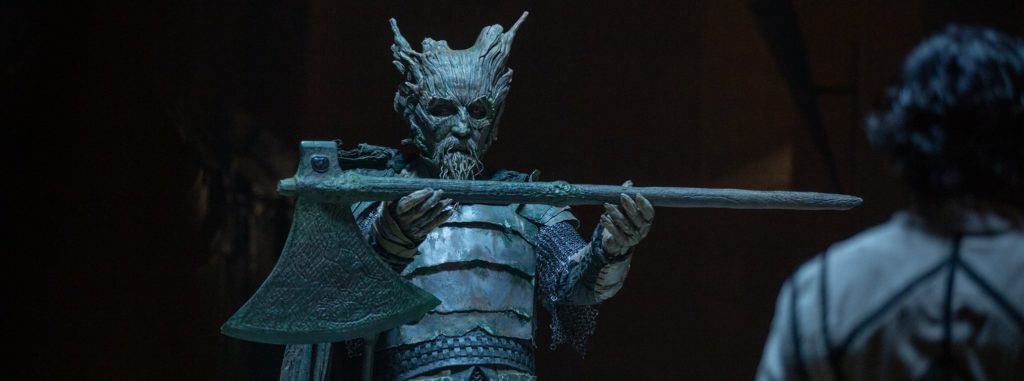
Turzanska commented regarding the Green Knight’s armour that she incorporated symbols from an ancient South Arabian language, the ‘Sabaic alphabet’ (see Inoa, 2021) which are visible on the upper breastplate. This heightens the monster’s connection with older times and other places, increasing his enigmatic qualities, while his features: informed by Tolkien’s Ents (anthropomorphic tree beings) (see Gower in Welch, 2021), gnarled trees generally and natural grey tones, link him with the landscapes of the film, giving the figure a ‘mystical aura…correspondingly organic’ (Gower in Welch, 2021). Interestingly having highlighted these remote qualities: grandeur, deep time and otherness generally, Lowery wanted the Green Knight to have a quality of gentleness ‘a sadness and sorrow to him’ (Gower in Welch, 2021): which Lowery shows in a scene where the Green Knight appears to be waiting sorrowfully for Gawain in a close shot of Ineson’s face. A pondering juxtaposed with Gawain’s own memories and worries that could be taken as a sign of the monster’s empathy. For Kermode the personality of Lowery’s Green Knight is ‘legion’ implying an unknowable and infinitely projectable figure. The jocular aspect of the monster is echoed in the final scene where The Green Knight playfully remarks ‘now off with your head’, we can’t be sure if Lowery wants us to take this positively (as in, now go with your head on your shoulders) or if he means us to recall the mad queen from Alice’s Adventures in Wonderland (1865) but my feeling was the former.
Lowery’s film is not without thoughtful criticism, the artist Clive Hicks-Jenkins – who has worked on a suite of prints that illustrated a special edition of Simon Armitage’s translation – explained regarding the portrayal of the Green Knight, ‘one of the several aspects of it that most bothers me is that the Green Knight in it is not presented as a ‘green’ man but as some second cousin to a forest spirit out of Lord of the Rings, and that as a result his beheading and resurrection has no sense of visceral horror’ (Hicks-Jenkins, in correspondence with the author 2021). That criticism seems to problematise the exact rationale for the idea, as discussed earlier Lowery’s presentation in that vein was intentional and was realised well, but as an adaptation – from a complex layered poem – it reifies one point of view, and Hicks-Jenkins is right, the complexity of the figure as a result is reduced. However, the opportunity to create a monster that was more nuanced: terrifying but beautiful, powerful but vulnerable, was sacrificed in order to produce a figure that played into the established fantasy languages already prominent in popular culture in a credible but rather predictable way. The success of this adaptation is in its celebration and accentuation of the feminine voices, its sumptuous costumes and landscapes and its clear superiority to previous attempts, it outclasses Weeks’ efforts entirely and its budget and ambition mean it demands greater attention than Phillips’s television film.
In the end, it would have been good to have seen something harder, more violent and more directly horrific. Gawain’s fall from grace for example is powerful in the poem because he is the best of the knights. His subjective growth is all the more powerful because he is a serious, accomplished extremist who is nevertheless forced to see himself and the world differently, to gain a condition in the present above and beyond his naïve and idealised notions of masculinity. Patel’s slacker Gawain (a major departure from the young knight of the poem) was never going to be that tragic.
Adaptations are never conclusive, they allow us to see the interpretation of another but can leave us disappointed, we are left eager for an authoritative horror version of Sir Gawain and the Green Knight where the figures are pushed to greater extremity. Gawain is ready to die to protect an idea of himself and his society from being proven false, the moment of potential beheading contains an exquisite tension because of its implications: to live but without your comfortable framing of the world, or die a perfect cipher, are existential and both disturbing prospects. The dissonance and sheer physical and psychological threat was missing in The Green Knight (2021) and leaves open opportunities for a future adaptation – one which manifests the retributive antagonism between the social world and the deeper world suggested in earlier texts.
References
Aronstein, S., & Drummond, T. (2021) [Review of the book The Green Knight, by David Lowery]. Arthuriana 31(3) :90-92. doi:10.1353/art.2021.0030.
Carroll, L. (1865) Alice’s Adventures in Wonderland. UK, Macmillan.
Gawain and the Green Knight. (1973) [film] Directed by S. Weeks. United Kingdom, United Artists.
Gawain and the Green Knight. (1991) [TV film] Directed by J.M. Phillips. United Kingdom, Thames Television.
Inoa, C. (2021) How the Costumes of ‘The Green Knight’ Helped Tell Its Magical, Surreal Story. [online] Observer. Available at: <https://observer.com/2021/08/the-green-knight-costume-designer-interview/> [Accessed 8 June 2022].
Kermode, M. (2021) The Green Knight review – a rich and wild fantasy. [online] the Guardian. Available at: <https://www.theguardian.com/film/2021/sep/26/the-green-knight-review-david-lowery-dev-patel-gawain> [Accessed 7 June 2022].
Sword of the Valiant. (1984). [film] Directed by S. Weeks. United Kingdom: Cannon Films.
The Green Knight. (2021) [film] Directed by D. Lowery. USA: A24.
Welch, A. (2021) How ‘The Green Knight’ Brought Its Most Iconic Character To Life. [online] INVERSE. Available at: <https://www.inverse.com/entertainment/the-green-knight-ralph-ineson-design-interview> [Accessed 27 February 2022].
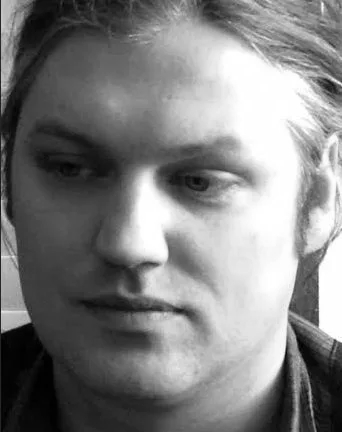
Michael Eden is an artist and researcher working in London and the south east, his artistic practice is concentrated on painting and he divides his time between this and lecturing in art history and contextual studies.

